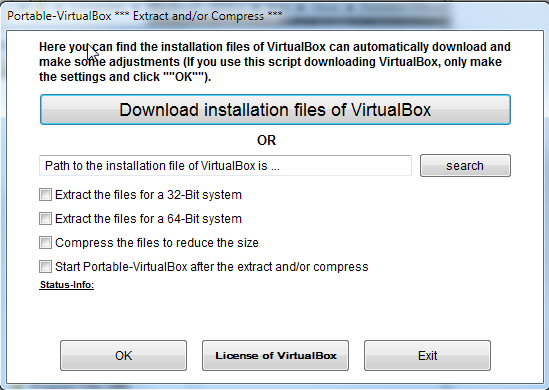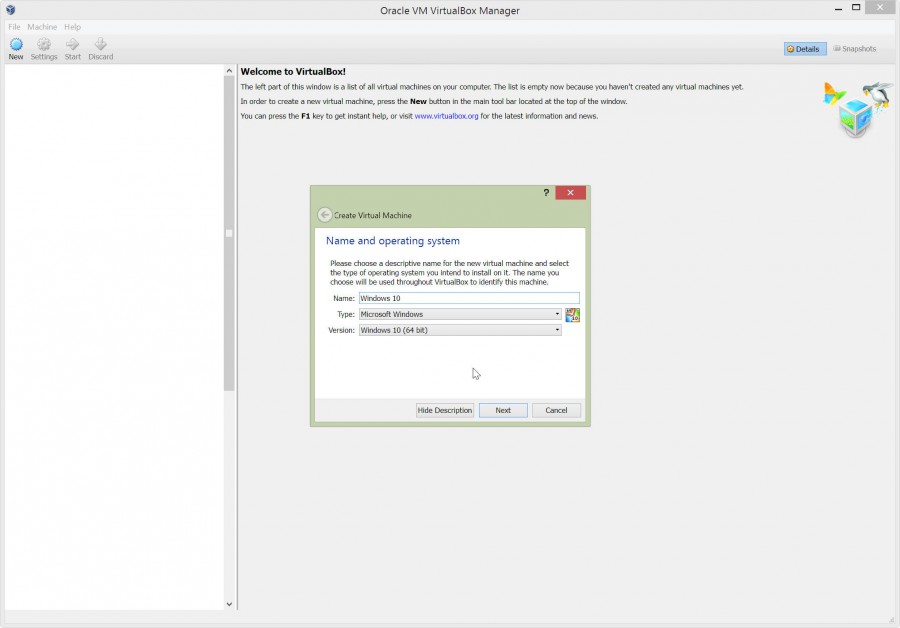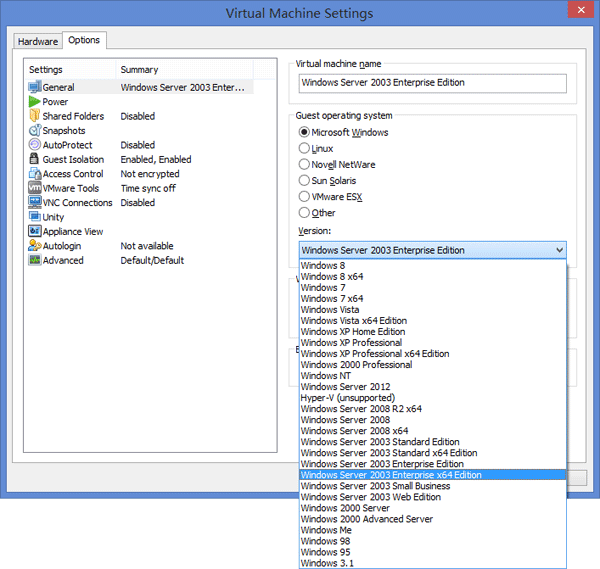- Oracle Vm Virtualbox Manager 32 Bit Windows 10
- Virtualbox Download 32 Bit Windows 10
- Oracle Vm Virtualbox Manager 32 Bit Free
- Oracle Virtualbox Download 32 Bit
- Virtualbox 6 32 Bit
- Oracle Vm Virtualbox Manager 32 Bit Torrent
Install and run multiple operating systems as virtual machines and tweak advanced features, such as shared folders, seamless windows, and 3D virtualization
Sep 24, 2021 For further details, refer to the 'Virtual networking' chapter of the Oracle VM VirtualBox User Manual. Attaching Virtual Media to a VM. Like a real computer, your VM needs a storage device, such as a hard disk, to boot from and for storing and retrieving system and user data. Some of the software aliases include 'Sun xVM VirtualBox Guest Additions', 'Sun xVM VirtualBox', 'Sun VirtualBox Guest Additions'. The most popular versions of the software are 6.1, 6.0 and 5.2. This free software is a product of Oracle Corporation. This free PC program is compatible with Windows XP/Vista/7/8/10 environment, 32 and 64-bit versions.
What's new in Oracle VM VirtualBox 6.1.26 Build 145957:
- This is a maintenance release. The following items were fixed and/or added:
- VMSVGA: fixed VM screen artifacts after restoring from saved state (bug #20067)
- Storage: Fixed audio endianness for certain CUE sheet CD/DVD images.
- VBoxHeadless: Running VM will save its state on host shutdown
Whether you are a professional software tester or you simply like to evaluate a large array of apps before choosing the one that best suits your necessities, you probably know that a virtualized environment can save you a lot of trouble: you can install any app without worrying it might mess up your previous settings and you can get rid of it just as easily.
And if you want to test the same app on several operating systems, Oracle VM VirtualBox can be quite helpful.
User-friendly layout and steps to follow for adding a new machine
Oracle Vm Virtualbox Manager 32 Bit Windows 10
The application comes with an intuitive interface that allows users to add a new virtual machine and choose the OS they prefer (be it Solaris, Windows, Linux, BSD or Mac OS X), as well as the exact version.
VirtualBox 6.0.0 SDK has been released by Oracle on the same day. Developers can download it from the link in the summary box below the article. VirtualBox 6.0.0 is a major upgrade of the virtualization software for 64-bit operating systems. The new version improves several features. Sep 17, 2021 Virtualbox For Macbook. Open VirtualBox. Click 'new' Type the name for virtual machine and Mac OS X for type. Choose your version (if you have Mojave or Catalina, choose Mac OS X (64 bit)). Select memory size. Select 'Create Virtual Disk Now' Choose VDI for format. Select storage name and size. The size should be at least 32 GB. Go to 'Settings'. In Oracle VM Manager, set the domain type for the virtual machine to Xen PVM. Oracle Solaris 10 supports x86 32-bit and 64-bit architecture. 32-bit or 64-bit mode is selected at OS boot time by examining the hypervisor and the underlying hardware. Oracle Solaris 11 supports x86 64-bit.
The next steps include assigning the new virtual machine the amount of RAM and HDD space it will take, as well as the type of storage, dynamic or fixed, it is to occupy on the PC.
Working with virtual machines
In order to launch any virtualized OS, you simply need to press the Start button - once it is running, you can pause, reset or close your virtual machine, or even clone it or create a dedicated desktop shortcut to help you open it whenever you need it.
Advanced features
If you are an expert user, you can also benefit from the specialized functions of Oracle VM VirtualBox, such as shared folders, seamless windows, 3D virtualization, multi-generation branched snapshots, remote machine display and modularity.
Oracle VM VirtualBox also features versatile hardware support, so that you can create virtual machines that have multiple virtual CPUs (regardless of how many cores you have physically on your PC), that recognize USB devices or ones that come with multi-screen resolutions, integrated iSCSI support and PXE network boot.
A top product on the market
To wrap it up, it is safe to say that Oracle VM VirtualBox can come in handy to both novices and experts: while the former can get their virtual machines up and running in no time, the latter can customize their virtualized environment to the tiniest details.
VirtualBox Video Guide
Filed under
Oracle VM VirtualBox was reviewed by Giorgiana ArghireOracle VM VirtualBox 6.1.26 Build 145957
Softpedia Editor's Pickadd to watchlist send us an update
send us an updateVirtualbox Download 32 Bit Windows 10
- runs on:
- Windows 10 32/64 bit
Windows Server 2012
Windows 2008 R2
Windows 2008 32/64 bit
Windows 2003
Windows 8 32/64 bit
Windows 7 32/64 bit
Windows Vista 32/64 bit
Windows XP 32/64 bit - file size:
- 103 MB
- filename:
- VirtualBox-6.1.26-145957-Win.exe
- main category:
- System
- developer:
- visit homepage
top alternatives FREE
top alternatives PAID
Oracle VirtualBox is a cross-platform virtualization application. It installs on your existing Intel or AMD-based computers, whether they are running Windows, Mac, Linux or Solaris operating systems. VirtualBox can create and run a 'guest' operating system (virtual machine) in a window of the host operating system. The virtual machine provides a self-contained environment in which to experiment with new software without risking damaging changes to the host operating system.
We will give an instruction with step-by-step screenshots to show how to install VirtualBox with an example of installing Ubuntu OS as a guest machine. We also explain how to share files between the host and guest operating systems.
Downloads
Note the instruction here is based on the latest version of the VirtualBox. If you have already installed an earlier version of VirtualBox, your experience may be different. It is recommended to use the latest version of VirtualBox to avoid issues. The VirtualBox forum is a good place to find a solution if you see any problems.
Go to VirtualBox website here to download the binary for your current operating system. Since our host machine is running on Windows, I'll choose 'x86/amd64' from Windows hosts. When download is finished, run the executable file. Continue with the installation of VirtualBox with the defaults. This will open VirtualBox at the end of the installation.
Create Virtual Machine
Click 'New' button to open a dialog.
Type a name for the new virtual machine. Since I am planning to install Ubuntu 14.04, I'll enter 'ubuntu1404'. Note that VirtualBox automatically changes 'Type' to Linux and 'Version' to 'Ubuntu (64 bit)'. These two options are exactly what we need.
Oracle Vm Virtualbox Manager 32 Bit Free

The memory size depends on your host machine memory size. In my case, I have 12GB physical RAM. I like to allocate as much as possible for Ubuntu but leave some for my Windows host machine. I pick 8192 MB for my Ubuntu. Note that VirtualBox will create a swap partition with the same amount space as base memeory you have entered here. So later when you are selecting the size of the virtual hard drive, make sure it is large enough since the hard drive will be splitted into root (/)and swap partitions. The root partition contains by default all your system files, program settings and documents.
Accept the default 'Create a virtual hard drive now' and click 'Create' button.
Continue to accept the default 'VDI' drive file type and click 'Next' button.
Change the storage type from the default 'Dynamically allocated' to 'Fixed size' to increase performance.
For the virtual hard drive space, the default value is 8GB which is too little for RNA-Seq analysis. I'll pick 100GB since I have plenty of space in my hard disk. You want to choose a good size for your RNA-Seq analysis. If you realize the drive space is not large enough, you'll need to go over these steps again to create another virtual machine.
Click 'Create' button and VirtualBox will generate Ubuntu virtual machine.
Now the virtual machine is created. We are ready to install Ubuntu in this virtual machine. Select your new virtual machine and click 'Settings' button. Click on 'Storage' category and then 'Empty' under Controller:IDE. Click 'CD/DVD' icon on right hand side and select the ubuntu ISO file to mount.
Oracle Virtualbox Download 32 Bit
Note that if you have not downloaded 64-bit Ubuntu ISO file, you can check out this page for more information. When downloading Ubuntu ISO file, make sure to selecte 64-bit version. Also make sure the VT-x/Virtualization Technology has been enabled in your computer's BIOS/Basic Input Output System.
Since Tophat program can take an advantage of multiple processors/threads, it is a good idea to specify a large number of processors in virtual machine (default value is 1). You can change this number by clicking on 'System' category. In this case, I change the number of CPUs to 4 since 4 is the largest value shown on the green bar in my case. Now you can click 'OK' button to continue.
VirtualBox may pop up a message about 'Auto capture keyboard' option. Read the message there and check 'Do not show this message again' option before clicking OK.
Install Ubuntu
Virtualbox 6 32 Bit
Back to Oracle VM VirtualBox Manager, click on the new Ubuntu virtual machine and hit 'Start' button. Now you shall see a 'Welcome' screen. Click 'Install Ubuntu' button. Note that the installation process may differ a little bit from version to version. The screenshots here are based on Ubuntu 14.04.1.
Click 'Continue' button.
Make sure 'Erase disk and install Ubuntu' option is selected and click 'Install Now' button.
Ubuntu will ask you a few questions. If the default is good, click 'Continue' button.
In 'Who are you?' dialog, enter your preferred name, username and password. Note that this user will have root/sudo privilege. Click 'Continue' button.
The installation will continue until it is finished.
After installation is complete, click 'Restart Now' button. When you see a screen with a black background saying 'Please remove installation media and close the tray (if any) then press ENTER:', just follow it.
Enter the password you have chosen and press 'Enter'.
The Ubuntu Desktop OS is ready. You may find the desktop screen is too small. Don't worry. You can solve this easily with 'VirtualBox Guest Additions'.
More About VirtualBox
Guest Additions
After the Ubuntu guest machine is installed, you will find the Ubuntu OS screen size is not extendable and you are not able to share folders between the host machine and Ubuntu.
Guest Additions software provide additional capability to a guest virtual machine, including mouse pointer integration, better video support, share folders, share clipboard, et al.
Before we proceed to install Guest Additions, make sure the current user has sudo/root privilege. If the current user does not have sudo/root privilege or it is not sure, run the following terminal command from an account (such as the user created when Ubuntu was first created; see the screenshot of 'Who are you?' above) with root privileges to enable the root privilege for the current user where USERNAME should be replaced by the current user's name.
To install Guest Additions, click Devices > Insert Guest Additions CD images…
Click 'Run' button (next to 'Cancel' button) to start the installation. Note that the version of VBOXADDITIONS should be matched with the one of VirtualBox you have installed.
Oracle Vm Virtualbox Manager 32 Bit Torrent
Installing Guest Additions requires root privilege. Enter user's password (assume the current user has sudo privilege).
When the installation is finished, press Return key to close the terminal window.
Now prepare to restart the system to enable the change. Click 'Shutdown' on the menu and then the 'Restart' button.
After rebooting Ubuntu, you will see the desktop resolution is much better.
Share Folders
Before you can enable shared folders on the host machine, make sure you have installed VirtualBox Guest Additions software on the guest machine.
When Ubuntu guest machine is on, click on Devices > Shared folders settings…
Select Machine Folders and hit the add button (plus sign).
Browse to the folder you wish to access from the guest machine. Check Auto-mount and Make Permanent options and click OK button.
Click OK button once more.

Now type 'terminal' in Dash to open a Terminal.
Type the following line in the Terminal to add a user to 'vboxsf' group. This step is necessary in order to use the VB's 'Shared Folder' feature.Replace 'brb' with your account name in Ubuntu.When you are done, restart the Ubuntu guest machine and go to /media/ directory. From Nautilus (file manager in Ubuntu), click Computer > File System > Media folder and inside it you will see a folder beginning with sf_ (the folder name is sf_Downloads in our example). Now you can transfer files between the Ubuntu guest machine and the Windows host machine in Nautilus.
Although Shared Folder system in VirtualBox is a nice feature, using VirtualBox shared folder directly for fastq data, annotation or output directorycan significantly reduce the performance compared to a native (Ubuntu) system or VirtualBox native system.
BRB-SeqTools
After Ubuntu has been successfully installed on VirtualBox, users can be go back to download and use BRB-SeqTools program.